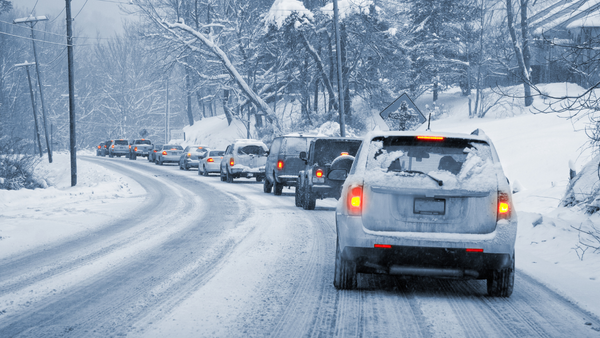Winter driving conditions are dangerous. According to the National Highway Traffic Administration, 17% of all injury and death traffic accidents occur during winter driving conditions. It is important to learn how to drive safely in winter conditions.
Snow, ice, sleet, obscured vision, difficult stopping and turning conditions can make for a challenge for motorists. Here are some tips from Chalat Hatten & Banker to help you drive more safely in the winter months.
Prepare
Have the shop test your battery. Replace it if its failing. Before you drive in winter conditions do a walk around the car. Check your headlights, both low and hi-beams. Check your turn signals, brake lights, 4-ways and interior lights. Newer cars have “Daytime running lights,” or DRL’s. These are essentially full-time low beam illuminations which make it easier to be seen even during daytime hours. Pack an emergency bag with warm clothes, gloves and hats, a flashlight, and some water and snack foods so you can get by if you are stuck in traffic or stuck in a snowbank. Make sure you have all the essentials in your car in case you get stuck. A snow shovel and a bag of salt/kitty litter can assist you to dig your wheels out of a ditch and give them traction on the snow/ice. Keep a blanket and bottles of water in your car in case you get stuck and are waiting for help. Other things to have in your car include jumper cables, flashlights, spare tire, window washer fluid and a snow scraper, spare clothes, tow rope and flares.
What conditions are your tires in? We at the firm usually switch to snow tires at Halloween and go back to road tires on Memorial Day. This is expensive, but its less expensive than an accident. Make sure your tires are in good condition – this is an important part of the “walk around,” look for worn treads, make sure one tire isn’t flatter than the other 3. Consider checking your spare situation. Some modern cars don’t come with spares or come with small emergency tires only. Be mentally prepared to change a tire. Figure out how to get to the spare, the jack and the tire iron/lug wrench, and how to change the tire on your own.
Check your wiper blades both front and if you’re in a station wagon or SUV, the wiper for the back window. Making sure your windshield wipers and defrosters are working is vital to staying safe while driving in the snow. Right maintained windshield wipers are a necessity; there are also extra blades available that are better fitted to help clear snow from your window shield.
Check your window washer fluid. This is easy, it’s the plastic container just under the hood.
If you are in an EV, make sure you’re charged up before winter driving. The battery load on your EV is much higher in cold weather, and you’ll see a decrease in range and remaining time if you are not topped off for a charge.
In gasoline or hybrid cars, the same holds true. You will see a decrease in MPG because of stop and go traffic, a high load on the engine and battery, and lost traction. Fill it up before you start your journey.
Decrease Your Speed While Driving
According to the U.S. Department of Transportation, 24% of annual weather-related auto crashes occur on snowy, icy, or slushy roads. And more than 1,300 people are killed on icy or snowy road conditions annually. The most significant thing to do when driving on slippery roads is to slow down. Stopping on slippery roads may take 2 to 10 times longer to stop compared to stopping on a dry road. Be sure to increase your following distance of another vehicle to 8 – 10 seconds.
Don’t Not Use Cruise Control
You should never use cruise control when driving in winter conditions. You want to be able to have manual control over your vehicle, having cruise control on reduces the driver’s reaction time if you happen to hit a patch of ice and can make it more likely to get in an accident.
Be Mindful of Snowplows
Snowplows have the absolute right of way. Stay back, don’t pass unless there is clearly an open lane on the snowplow’s left. Don’t tailgate a snowplow. Plows drop de-icer and sand to treat Colorado highways during a snowstorm. Drivers who follow too close risk damage to their vehicle from the de-icer and sand. Snowplows can also stop abruptly. Motorists should leave plenty of room (at least 3-4 car lengths from a plow) to avoid a potentially serious collision. never pass a snowplow on the right. Snowplows are designed to push the snow, slush, and other damaging debris like rocks to the right of a roadway. Attempting to pass a plow on the right could not only damage a vehicle but also obstruct visibility.
THE DENVER CAR ACCIDENT LAWYERS AT CHALAT HATTEN & BANKER
For more than three decades, the attorneys at Chalat Hatten & Banker PC have helped individuals and their families obtain justice and compensation after a car accident. If you’ve been injured in a car, truck, pedestrian, bus, or motorcycle accident, please call the car accident attorneys at Chalat Hatten & Banker at 720-809-7382 or send us an email below for a free, no-obligation evaluation of your case. We serve clients around the state of Colorado, including Denver, Fort Collins, Boulder, Aurora, Littleton, Colorado Springs, and Pueblo.
